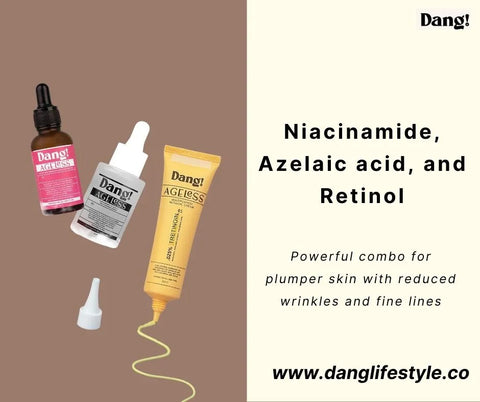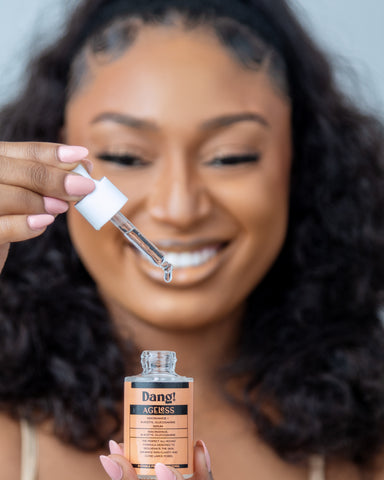
Can I Use Niacinamide, Azelaic Acid, and Retinol Together?

Buckle up, skincare enthusiasts, as we explore these three superstar skincare ingredients: niacinamide, azelaic acid, and retinol.
Niacinamide is a form of vitamin B3 that addresses various skin concerns, like uneven skin tone, enlarged pores, fine lines, and dullness. Azelaic acid is known for its anti-inflammatory properties. It effectively combats acne, rosacea, and hyperpigmentation, promoting clearer skin. Retinol, the anti-ageing superstar, stimulates collagen production and accelerates cell turnover, reducing wrinkles, fine lines, and breakouts.
If you've ever asked the question, Can I use niacinamide, azelaic acid, and retinol together? The answer is yes, and in this post, we'll show you how.
We'll also explain the science behind these ingredients, their benefits, potential side effects, and tips for mitigating these side effects.
Key Takeaways: Using Niacinamide, Azelaic Acid and Retinol Together
-
Niacinamide, azelaic acid, and retinol are powerful skincare ingredients that complement each other well. When used together, they can address skin concerns like uneven skin tone, acne, hyperpigmentation, and signs of ageing.
-
Niacinamide minimises pores, calms redness, and strengthens the skin barrier. Azelaic acid combats acne, brightens hyperpigmentation, and reduces inflammation. Retinol stimulates collagen production, diminishes wrinkles, and refines skin texture.
-
The combination of niacinamide, azelaic acid, and retinol provides enhanced anti-ageing benefits, leading to firmer, plumper skin with reduced wrinkles and fine lines.
-
Before incorporating these ingredients into your skincare routine, consider factors such as your skin's sensitivity/tolerance levels and the concentration levels of each ingredient.
Can I Use Niacinamide, Azelaic Acid, and Retinol Together?
The million-dollar question we get asked all the time as skincare professionals! Niacinamide, azelaic acid, and retinol are three powerhouse ingredients, each offering impressive benefits for radiant skin. But do these powerhouse ingredients work well together when combined in a single routine?
First, let's find out the benefits of each ingredient.
Understanding the Benefits of Each Ingredient
-
Niacinamide: Research reveals that niacinamide offers several benefits for the skin. It improves the appearance of the skin texture, reduces hyperpigmentation, minimises pores, and optimises your skin's overall health.
-
Azelaic acid: Studies reveal azelaic acid to be an active ingredient for combating acne, and inflammation.
-
Retinol: It promotes collagen production, fades wrinkles, and refines skin texture. Retinol is the ultimate anti-aging warrior.

Benefits of Combining Niacinamide, Azelaic Acid, and Retinol in a Skincare Routine
Now, let's delve deeper into the potential benefits you can unlock by using these ingredients strategically:
Glowing, Even-Toned Skin:
-
Niacinamide balances oil production, minimising the appearance of enlarged pores.
-
Azelaic acid fades hyperpigmentation and dark spots, promoting a brighter, more even skin tone.
-
Retinol exfoliates and eliminates dead skin cells, revealing a radiant complexion.
Together, they can leave you with glowing and even-toned skin.
Enhanced Anti-Ageing Effects:
-
Niacinamide stimulates collagen production, leading to firmer, plumper skin.
-
Retinol also enhances collagen production, reducing the appearance of wrinkles and fine lines.
This combo defies ageing signs, leaving you with a youthful and radiant look.
Blemish-Free, Clear Complexion:
-
Azelaic acid combats acne-causing bacteria and reduces inflammation, preventing future breakouts.
-
Retinol promotes cell turnover, preventing clogged pores and blemishes.
Overall, using azelaic acid and retinol together helps you effectively combat acne and premature ageing simultaneously.
Factors to Consider Before Using Niacinamide, Azelaic Acid and Retinol Together
Skin Sensitivity and Tolerance
These are active ingredients. They are effective individually. However, using them together might be too much for some skin types, especially sensitive skin.
So, start slow, introduce one ingredient at a time, and monitor your skin's reaction to these ingredients individually before combining them.
Product Formulation
Not all products are created equal. Some products are formulated with a high dosage or concentration of active ingredients. This is something you'll want to consider, especially if you have sensitive skin.
Listen to your Skin
Regardless of how great a product is, always listen to your skin. If you experience any irritation, redness, or excessive dryness, discontinue use. Alternatively, you can reduce how often you use the products to once a week. n
Overall, always consult an aesthetician for professional advice in situations like these.
Sun Protection
Incorporating retinol into your skincare routine may increase sensitivity to the sun, making sun protection a non-negotiable step. Always apply a broad-spectrum sunscreen with an SPF of 50 or higher during the day to protect your skin from harmful UV rays in the environment.
Ultimately, by understanding how niacinamide, azelaic acid, and retinol work individually and combined, you can make informed decisions about incorporating them into your skincare routine for optimal results.
Remember to patch test new products on the inside of your forearm and consult with a skincare professional to ensure compatibility of skincare actives like these and receive personalised recommendations based on your skin's unique needs.

How to Incorporate Niacinamide, Azelaic Acid, and Retinol into Your Daily Routine
Here's a daily skincare routine incorporating these powerhouse ingredients.
Morning Routine:
1. Cleanser: Start your routine with a gentle everyday face wash to remove any impurities accumulated overnight.
2. Vitamin C serum (optional): After cleansing, apply a vitamin C serum to your face and neck. Vitamin C is a powerful antioxidant that helps protect the skin from environmental damage, brightens the complexion, and promotes collagen production.
Ensure to use the right type for your skin type: Vitamin C for oily/combination skin skin types and Vitamin C for dry/normal skin type
3. Niacinamide Serum: After cleansing, apply a niacinamide serum. Allow it to absorb fully before proceeding to the next step.
4. Moisturiser: Follow up with a day cream/face moisturiser. This will provide essential hydration.
5. Sunscreen: Finish up with a sunscreen with at least SPF 50. Don't forget to reapply every two hours, especially if you're outdoors, sweating, or swimming.
Ensure to use the right type for your skin. Sunscreen for oliy/combination skin type. Sunscreen for dry/normal skin types.
Evening Routine:
1. Cleanser: Cleanse your face again to remove makeup, sunscreen, and any accumulated dirt and oil from throughout the day.
2. Azelaic Acid Treatment: After cleansing, apply a thin layer of azelaic acid treatment to target acne, hyperpigmentation, and inflammation. Allow it to dry completely before moving on to the next step.
3. Niacinamide Serum (Optional): If you prefer, you can reapply the niacinamide serum from your morning routine to further enhance its benefits.
4. Retinol Treatment: In the evening, apply a pea-sized amount of retinol treatment to your face, avoiding the delicate eye area. Start by using it every other night to allow your skin to adjust, then gradually increase to every night, depending on your skin's tolerance level.
As skincare experts, we recommend tretinoin 0.025% for a start. Among the different types of retinoids (retinol) out there, tretinoin proves to be the most effective for treating photoageing (premature ageing due to excessive exposure to harmful radiation in the atmosphere.)
5. Moisturiser: Follow up with a nourishing nighttime moisturiser to hydrate and replenish your skin's moisture barrier. This will help counteract any potential dryness or irritation from the active ingredients.
Possible Side Effects and How to Mitigate Them
Niacinamide, azelaic acid, and retinol are typically safe combinations for most skin types. This is because niacinamide acts as a soothing ingredient. Therefore, it can calm any irritation from these other products (azelaic acid and retinol)
However, there's a tendency for some individuals to react to retinol or other ingredients in this routine. This is especially true for sensitive skin types.
They may experience the following side effects;
Dryness and Skin Peeling:
Retinol has the tendency to cause dryness. Azelaic acid can intensify this reaction. As such, you may notice excessive dryness and peeling when combining both ingredients in the same routine.
To mitigate this side effect, consider using them separately, especially when using them for the first time. Then, you can consider using them together once your skin gets used to each ingredient.
Additionally, ensure to moisturise your skin after using these ingredients to prevent dryness. Alternatively, you can add a little bit of moisturiser to your retinol to buffer the side effects.
Increased Sun Sensitivity
Retinol and azelaic acid can increase your skin's sensitivity to the sun. This is why sunscreen with at least SPF 50 or more is essential to this routine.
Ensure that you use the right sunscreen for your skin type. For oily skin, a non-greasy, no-white cast mineral sunscreen is best for you. For dry skin, use a moisturising sunscreen for dry skin.
Ultimately, always make sunscreen the last step in your skincare routine, regardless of the weather. Don't forget to reapply every 2-3 hours if you're spending most of your time outdoors.
Over-exfoliation
It's easy to exfoliate when using retinol and azelaic acid together. This can lead to redness and irritation and weaken the skin's barrier.
To prevent this from happening, don't use other exfoliating products or physical exfoliants in this routine. Also, reduce the frequency of using exfoliants like retinol to once a week until your skin is able to tolerate the product.
Skin purging
Skin purging is when you notice more breakouts, especially when using a new active/product. This usually means that the product is working. Although this can be a very frustrating experience, it usually stops after a few weeks of using the product consistently.
To minimise purging, introduce these actives (azelaic acid and retinol) into your routine gradually. Start with lesser concentrations, then increase as your skin starts getting used to the product.
Final Thoughts
Combining niacinamide, azelaic acid, and retinol can give you radiant, youthful skin. These powerhouse ingredients address various concerns, such as uneven skin tone, acne, hyperpigmentation, and signs of ageing.
However, use them with caution, especially if you have sensitive skin.
Start by introducing each product slowly. Monitor your skin's reaction, and adjust your routine accordingly.
Also, use products with mild formulations of these actives. Finally, use sunscreen to reduce the chances of side effects like dryness, sensitivity to the sun, and over-exfoliation.
Ultimately, with patience, consistency, and a personalised approach, you can harness the power of these ingredients to unveil radiant, youthful-looking skin.
Ready to embark on a holistic self-care journey and unlock a radiant and confident YOU! Explore our newly launched collection.
FAQs: Can I Use Niacinamide, Azelaic Acid, and Retinol Together?
1. Is it better to put retinol on wet or dry skin?
It is generally advisable to apply skincare products on damp skin to allow for better absorption. However, this is not the case with retinol.
Applying it to damp skin will lead to deeper absorption, which may cause irritation. So, it's best to let your skin dry first before applying.
2. At what age should I use retinol?
Mid-20s–early 30s is a great time to start incorporating retinol into your skincare routine.
3. Why is my skin so dry when I start using retinol?
Some of the side effects of retinol include skin purging, dryness, and irritation. So, it's possible to notice dryness when you start using retinol.
However, these reactions usually stop after 4-6 weeks, when your skin has gained tolerance for this ingredient.
